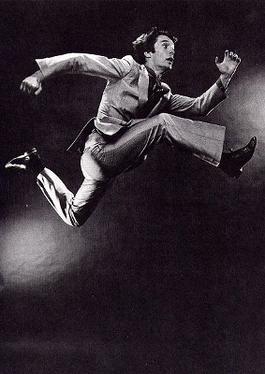Bill Cratty facts for kids
Bill Cratty (born February 28, 1951 – died September 9, 1998) was an American modern dancer and choreographer. A choreographer is someone who creates dance routines. He was known for making dances that were fun and told stories.
Contents
About Bill Cratty
Early Life and Dance Training
Bill Cratty was born William Anthony Cratty in Cleveland, Ohio. He started dancing at age 5, taking tap and gymnastics lessons. He stopped for a while but started again in high school, joining school musicals. Later, he studied dance at Ohio University and earned a special degree in dance in 1973.
Becoming a Professional Dancer
In 1974, Bill Cratty, who was over six feet tall, joined the famous José Limón Dance Company. He became a main dancer and performed with them for eight years. He danced in many important works by famous choreographers like Limón and Doris Humphrey. He also learned from other great dancers, and their jazzy style influenced his own dance creations.
Creating His Own Dances
Bill Cratty's first big dance piece was called "The Kitchen Table." The José Limón Company performed it in New York City in 1981. A dance critic named Walter Terry called it a very important dance work of the 20th century.
In 1982, Cratty started his own group, the "Bill Cratty Dance Theatre." His company traveled around the world and performed many times in New York. They even performed at the Kennedy Center in Washington, D.C.
Teaching and Performing
Bill Cratty was also a top teacher of the Limón dance style. He taught at many universities across America, including University of California at Santa Barbara and Harvard. He also helped other dance companies perform his works. He even appeared on Broadway in the musical Jerome Robbins' Broadway. He also danced with Mikhail Baryshnikov's White Oak Dance Project.
In 1993, Cratty moved to London to teach at the Laban Dance Centre. He also led their Transitions Dance Company. Bill Cratty passed away in London in 1998 at the age of 47.
Today, Ohio University gives out the Bill Cratty Award every year. It's a scholarship for male dance students, honoring his memory.
Bill Cratty's Dance Style
Bill Cratty's dances were seen as classic modern dance. This was special in the 1980s when many dances were becoming very simple and abstract. Cratty always wanted his dances to be entertaining. People praised his choreography for being funny, telling stories, and showing human feelings.
He loved movies with dancers like Fred Astaire and Gene Kelly. His own dances often mixed parts of serious concert dance with fun musical theatre. They sometimes included mime and comedy. One dance magazine said his work had a modern feel but also an old-fashioned modern dance style. As a performer, critics said he was "pure and concentrated" and had an "extraordinary stage presence."
Selected Dance Works
- The Kitchen Table (1980)
- Le Bourgeois Gentilhomme (1982)
- Promenades (1982)
- Match
- Opus No. 3
- Prince of the Air (1984)
- Englewood (1984)
- The Beethoven Quintet (1986)
- Salome (1986)
- Muggsy (1987)
- Going Bananas (1987)
- Andante Favori (1987)
- Down In The Hole (1995)
- Don't Be That Way (1996)
- Rebound (1997)
What Critics Said
- "Mr. Cratty is a strong and smart dancer with a great stage presence. His dances also have these qualities. It's rare to see dance today that seems to know where it's going, even when it's full of surprises."
-
- – Jennifer Dunning, The New York Times, 1982
- "Cratty's unique style comes from his love for the pure energy of dance mixed with his excitement for gymnastics. The result is movement that is free-spirited and tight, funny and entertaining."
-
- – Deirdre Kelly, The Globe and Mail, 1985
- "He has an old-fashioned respect for pure technique that, among many of his more trendy peers, has gone out of style."
-
- – Clive Barnes, New York Post, 1987



